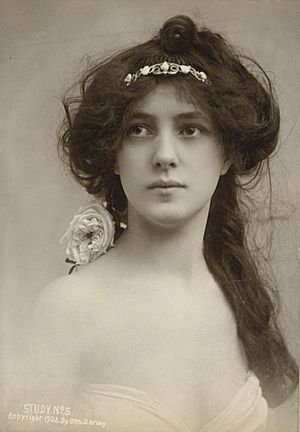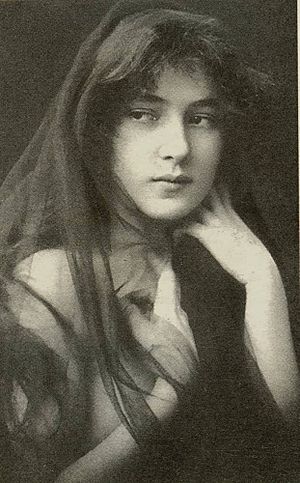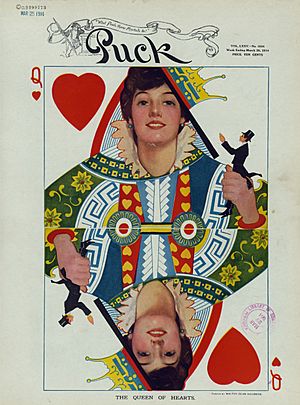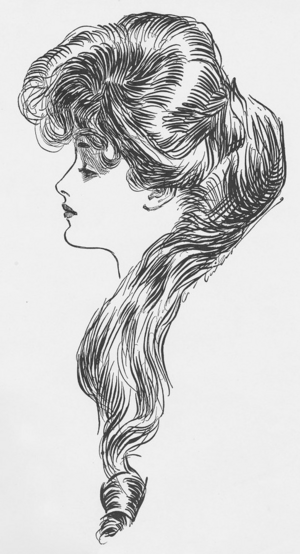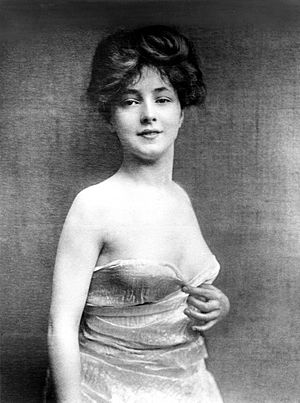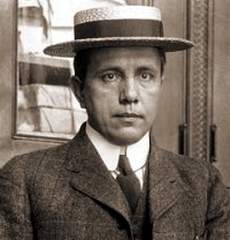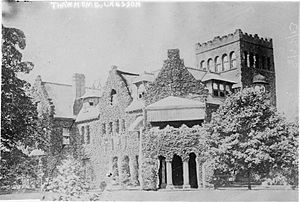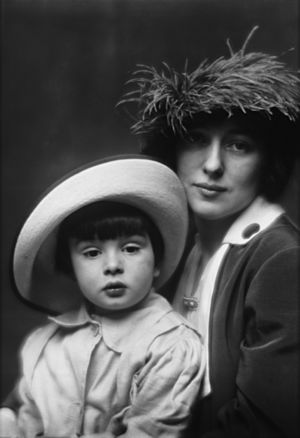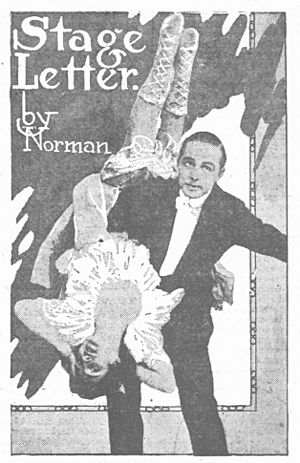Evelyn Nesbit facts for kids
Quick facts for kids
Evelyn Nesbit
|
|
|---|---|
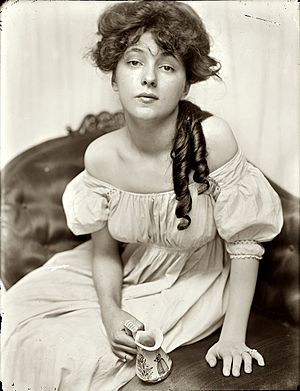
1903 photograph by Gertrude Käsebier
|
|
| Born |
Florence Evelyn Nesbit
December 25, 1884, or December 25, 1885 Natrona, Pennsylvania, U.S.
|
| Died | January 17, 1967 (aged 82) Santa Monica, California, U.S.
|
| Other names | Evelyn Nesbit Thaw |
| Occupation | Model, chorus girl, actress |
| Spouse(s) |
Harry Kendall Thaw
(m. 1905; div. 1915)Jack Clifford
(m. 1916; div. 1933) |
| Children | Russell William Thaw |
Evelyn Nesbit (born Florence Evelyn Nesbit; December 25, 1884 or 1885 – January 17, 1967) was an American artists' model, chorus girl, and actress. She became very famous in the early 1900s for her beauty. She appeared in many magazines and on stage.
Contents
Early Life and Family Challenges
Florence Evelyn Nesbit was born on December 25, either in 1884 or 1885. She was born in Natrona, Pennsylvania, a small town near Pittsburgh. As a child, she was mostly known as Florence Evelyn. The exact year of her birth is not certain. This is because local records were later destroyed in a fire. Evelyn herself was not sure of the year. Sometimes, her mother would say Evelyn was older than she was. This was to help her get around child labor laws. These laws stopped young children from working too much.
Evelyn's father was Winfield Scott Nesbit, an attorney. Her mother was Evelyn Florence. Evelyn felt very close to her father. He encouraged her to read and learn. He even set up a small library for her. It had fairy tales, fantasy books, and adventure stories. When Evelyn showed interest in music and dance, her father supported her lessons.
The Nesbit family moved to Pittsburgh around 1893. When Evelyn was about 10, her father died suddenly. This left the family with no money. They lost their home, and their belongings were sold to pay debts. Evelyn's mother tried to find work as a dressmaker but struggled. The family had to rely on help from friends and relatives. They often lived like nomads, moving from one rented room to another. Evelyn's younger brother, Howard, sometimes stayed with relatives.
Her mother later rented a house to run as a boardinghouse. This was to earn money. Sometimes, young Evelyn, around 12, had to collect rent from the people staying there. Evelyn later wrote that her mother "was always worried about the rent." Running the boardinghouse was difficult for her mother, and it did not work out.
Moving to Philadelphia and First Jobs
Because they had money problems, Mrs. Nesbit moved to Philadelphia in 1898. A friend told her she might find work there as a seamstress. Evelyn and Howard first stayed with an aunt. Then they moved to a family in Allegany, Pennsylvania. Mrs. Nesbit did find a job, but not as a seamstress. She worked as a sales clerk at the fabric counter of Wanamaker's department store.
She then sent for her children. Both 14-year-old Evelyn and 12-year-old Howard also started working at Wanamaker's. They worked long hours, twelve hours a day, six days a week.
One day, an artist saw Evelyn at the store. He was amazed by her beauty. He asked her to pose for a portrait. Her mother agreed. Evelyn posed for five hours and earned one dollar. This was like earning about $27.50 today. She then met other artists in Philadelphia. She became a favorite model for many well-known illustrators and painters. Evelyn realized she could earn more money posing for artists than working at Wanamaker's. She convinced her mother to let her become a full-time model.
Becoming a Famous Model
In June 1900, Evelyn's mother moved to New York City to find work. She left her children with others. She struggled to find a job there. In November 1900, she finally sent for Evelyn and Howard. The family shared a small room in Manhattan.
Evelyn's mother used letters from Philadelphia artists to meet painter James Carroll Beckwith. He was a respected painter and teacher. He helped Evelyn by introducing her to other artists.
Evelyn's mother had to manage her daughter's career. However, she found it hard to handle the business side and protect her daughter.
Evelyn quickly became one of the most popular artists' models in New York. Photographers like Otto Sarony and Rudolf Eickemeyer worked with her. Her face appeared on the covers of many popular women's magazines. These included Vanity Fair, Harper's Bazaar, and Cosmopolitan.
She also appeared in advertisements for many products. Her image was on sheet music, beer trays, tobacco cards, and postcards. Evelyn often posed in different costumes for these pictures. She also modeled for calendars for companies like Prudential Life Insurance and Coca-Cola.
Charles Dana Gibson, a very famous artist, used Evelyn as a model for one of his "Gibson Girl" drawings. The "Gibson Girl" was a popular image of the ideal woman at that time. His drawing, called Woman: The Eternal Question (around 1903), shows Evelyn's profile. Her long, beautiful hair forms the shape of a question mark.
Using photographs of young women in advertising was a new trend. Evelyn modeled for Joel Feder, a pioneer in fashion photography. She found these jobs easier than posing for artists. The pay was good. For a half-day shoot, she earned $5, and for a full day, $10. This was a lot of money back then. Soon, her modeling earnings were more than what her whole family made at Wanamaker's. However, living in New York City was very expensive.
Stage Career and Acting
Evelyn grew tired of the long hours and still poses required for studio modeling. Her popularity as a model caught the attention of people in the theater world. They offered her acting jobs. Evelyn convinced her mother to let her try acting. This new path would also help their family's finances.
Evelyn got a part in a Broadway show called The Wild Rose. The show's producer, George Lederer, thought she was very talented. He offered her a one-year contract. He also moved her from the chorus line to a special role as the Gypsy girl "Vashti." News about her quickly spread. On May 4, 1902, The New York Herald featured Evelyn in a two-page article. It had photos and talked about her rise from model to a key cast member. The newspapers often praised her beauty and strong stage presence. Her acting skills were not mentioned as often.
Family and Later Life
Evelyn Nesbit married Harry Kendall Thaw on April 4, 1905, in Pittsburgh. Harry was the son of a wealthy family who owned coal and railroad businesses. They lived in the Thaw family home, Lyndhurst, in Pittsburgh. Evelyn divorced Harry in 1915. When Harry Thaw died in 1947, he left Evelyn $10,000 from his large estate.
Evelyn had a son named Russell William Thaw. He was born on October 25, 1910, in Berlin, Germany. Russell appeared in several films with his mother. He became a skilled pilot. In 1935, he placed third in the Bendix Trophy race. This was a famous air race from Los Angeles to Cleveland. He finished ahead of the famous pilot Amelia Earhart.
Evelyn married her dance partner, Jack Clifford, in 1916. This news was on the front page of newspapers. Starting in 1913, Evelyn and Jack had a very popular stage act. They performed dance shows. In August 1913, she performed at New York City's Victoria Theater. In November 1913, they filled the Auditorium Theater in Chicago. Their marriage, however, did not last. Jack Clifford left her in 1918. Their divorce was final in 1933.
After her years in vaudeville, Evelyn performed in clubs and cabarets across the East, South, and Midwest.
After Harry K. Thaw died in 1947, Evelyn left New York City. She moved to California to be closer to her son, Russell, who lived in West Los Angeles. She chose to live in a creative neighborhood near Bunker Hill. There, she followed her interest in sculpting. She studied at the Grant Beach School of Arts and Crafts. After graduating in 1952, she taught classes in sculpting and ceramics.
Evelyn Nesbit wrote two books about her life. They were called The Story of My Life (1914) and Prodigal Days (1934).
Death
Evelyn Nesbit died in a nursing home in Santa Monica, California, on January 17, 1967. She was 82 years old. She had lived in the nursing home for over a year. She was buried at Holy Cross Cemetery in Culver City, California.
Stage Performances
- Florodora (1901)
- The Wild Rose (1902)
- Tommy Rot (1902)
Filmography
- Threads of Destiny (1914)
- A Lucky Leap (1916)
- Redemption (1917)
- Her Mistake (1918)
- The Woman Who Gave (1918)
- I Want to Forget (1918)
- Woman, Woman! (1919)
- Thou Shalt Not (1919)
- A Fallen Idol (1919)
- My Little Sister (1919)
- The Hidden Woman (1922)
- Broadway Gossip No. 2 (1932 short; as herself)
Images for kids
See Also
 In Spanish: Evelyn Nesbit para niños
In Spanish: Evelyn Nesbit para niños



